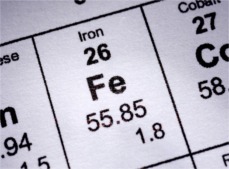Iron (Fe)
 Apart from having many world class scientists in the 18th and 19th centuries, the main reason that the UK became the first industrialised nation on Earth was the presence of abundant coal and iron. Large deposits of both were found all over England, Scotland and Wales. Even in areas with no commercial iron deposits, soils are still found to contain high levels of iron. One giveaway to the casual observer is the colour. The rich red soils common to many parts of the UK are all high in iron, but so are many of the dark brown clays and loams. The only soils of the UK that are low in iron are some of the chalks. Consequently, iron is rarely deficient; in fact most iron-related problems stem from excess, not deficiency. The relatively rare pure chalk soil may have 5-10 ppm of iron, whereas a mineral soil will often contain over 1000ppm. Soil samples taken in certain parts of the UK have the odour of rusty railings reflecting the high iron content.
Apart from having many world class scientists in the 18th and 19th centuries, the main reason that the UK became the first industrialised nation on Earth was the presence of abundant coal and iron. Large deposits of both were found all over England, Scotland and Wales. Even in areas with no commercial iron deposits, soils are still found to contain high levels of iron. One giveaway to the casual observer is the colour. The rich red soils common to many parts of the UK are all high in iron, but so are many of the dark brown clays and loams. The only soils of the UK that are low in iron are some of the chalks. Consequently, iron is rarely deficient; in fact most iron-related problems stem from excess, not deficiency. The relatively rare pure chalk soil may have 5-10 ppm of iron, whereas a mineral soil will often contain over 1000ppm. Soil samples taken in certain parts of the UK have the odour of rusty railings reflecting the high iron content. Iron in groundwater is acted upon by bacteria and forms ochreous sludges, which often resemble tomato soup, so are easy to identify. These ferrous sludges are very prone to blocking land drains and their presence is usually an indication of high soil iron levels.
Like manganese, iron becomes less plant-available as pH increases. Conversely, it becomes over-available in acid conditions, a property it shares with aluminium. It is therefore beneficial for livestock grazing these soils, to ensure that pH levels drop no lower than 5.7
Golf greens are frequently treated with iron sulphate, which is a very effective moss killer, but too much can create a black, anaerobic layer, formed by iron and other metals, through association with bacteria. This process releases hydrogen sulphide, which inhibits root growth.
